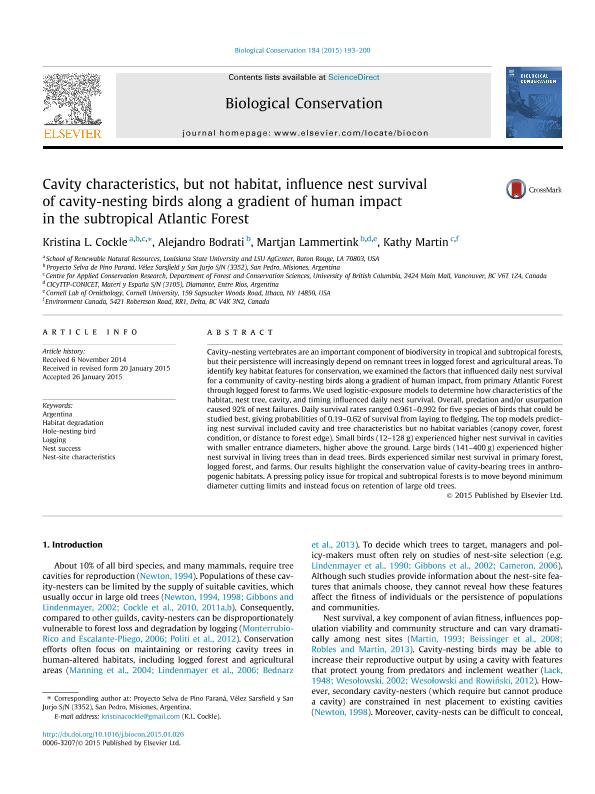Artículo
Cavity characteristics, but not habitat, influence nest survival of cavity-nesting birds along a gradient of human impact in the subtropical Atlantic Forest
Fecha de publicación:
04/2015
Editorial:
Elsevier
Revista:
Biological Conservation
ISSN:
0006-3207
Idioma:
Inglés
Tipo de recurso:
Artículo publicado
Clasificación temática:
Resumen
Cavity-nesting vertebrates are an important component of biodiversity in tropical and subtropical forests, but their persistence will increasingly depend on remnant trees in logged forest and agricultural areas. To identify key habitat features for conservation, we examined the factors that influenced daily nest survival for a community of cavity-nesting birds along a gradient of human impact, from primary Atlantic Forest through logged forest to farms. We used logistic-exposure models to determine how characteristics of the habitat, nest tree, cavity, and timing influenced daily nest survival. Overall, predation and/or usurpation caused 92% of nest failures. Daily survival rates ranged 0.961-0.992 for five species of birds that could be studied best, giving probabilities of 0.19-0.62 of survival from laying to fledging. The top models predicting nest survival included cavity and tree characteristics but no habitat variables (canopy cover, forest condition, or distance to forest edge). Small birds (12-128. g) experienced higher nest survival in cavities with smaller entrance diameters, higher above the ground. Large birds (141-400. g) experienced higher nest survival in living trees than in dead trees. Birds experienced similar nest survival in primary forest, logged forest, and farms. Our results highlight the conservation value of cavity-bearing trees in anthropogenic habitats. A pressing policy issue for tropical and subtropical forests is to move beyond minimum diameter cutting limits and instead focus on retention of large old trees.
Archivos asociados
Licencia
Identificadores
Colecciones
Articulos(CICYTTP)
Articulos de CENTRO DE INV.CIENT.Y TRANSFERENCIA TEC A LA PROD
Articulos de CENTRO DE INV.CIENT.Y TRANSFERENCIA TEC A LA PROD
Citación
Cockle, Kristina Louise; Bodrati, Alejandro; Lammertink, J. Martjan; Martin, Kathy; Cavity characteristics, but not habitat, influence nest survival of cavity-nesting birds along a gradient of human impact in the subtropical Atlantic Forest; Elsevier; Biological Conservation; 184; 4-2015; 193-200
Compartir
Altmétricas




